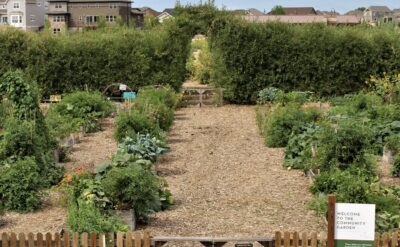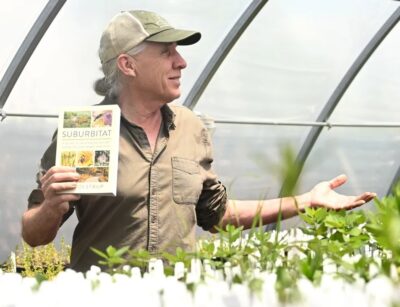“If you can read a book, you can do anything.” Short of embroidering it on a cushion, that’s a mantra I’ve lived by since my best friend in high school wised me up. I’ve packed in a lot of reading since then, researching the history of garden design and landscaping for the books I’ve written, as well as books on gardening how-to, accumulating a garden skill set adapted to a variety of locales, from London to rural Norfolk, and in the USA from Texas to Iowa to Pennsylvania to Colorado Springs.
Jim Tolstrup’s book, Suburbitat, a guide to restoring nature where we live, work and play, is the book I wish I’d had when I broke ground in the Rocky Mountains ten years ago; it’s not so much soil, but … as I say in my bio on this page … a prehistoric sand dune in a strange land where there’s six seasons…sometimes eight…the climate is mostly arid, the air is thin, and strong sunlight punishes plants and complexions, and it’s dry… very dry. All which goes to make gardening with arid-loving plants, mostly natives, a no-brainer. Jim’s work has focused on emphasizing the value and importance of the natural world, and to respecting it as a human resource, “not as a commodity, but as a community” of which we are all part. This inclusive view has brought him to his current position as Executive Director of the High Plains Environmental Center (aka HPEC) in Loveland, Colorado, a non-profit created by a forward-thinking developer cum conservationist who saw the potential in making a planned community with a nature preserve at its heart.

That’s not necessarily a new idea; in the post-WW2 years when planned communities were springing up across the USA to provide homes returning GIs and their young families, developers, architects and landscape designers of mid-century modern dwellings often worked hand-in-hand. I grew up in one such planned development south of Chicago that was created in a disused golf course, where mature trees were conserved, open spaces were ready-made, and forest remnants were nurtured for recreation; there were even pockets of farmland still in use and apple trees dotting the small fields. Sadly, it’s rare to see such practice today, particularly in wide-open spaces of the west, and especially in Colorado where, from the Pawnee National Grassland in the northeast to probable expansion around Fountain, southeast of Colorado Springs, the eastern prairie and its deep rich soils, native flora and free-range for fauna, is disappearing beneath dense housing developments.

Suburbitat is presented in three sections, each divided into chapters. The first, The Story of the Land, describes the evolution of the Rocky Mountain region from its primordial beginnings to development of the Centerra community with the HPEC gardens and native plant nursery at its heart — a different vision, as described in the eponymously named website, suburbitat.org.
The following sections and their respective chapters explore the vision of restoring, conserving, and where possible, the natural environment. This is where the yellow highlighting in my copy of Suburbitat comes on hot and heavy. Of particular interest was Tolstrup’s long engagement with the essence of place and his knowledge of the indigenous people’s millennia-old ways of managing the short grass prairies. In the chapter ‘A Garden of Reconciliation’, Tolstrup describes the Medicine Wheel Garden at HPEC, where plants used for food, ceremony, and medicine by the tribes of the High Plains are grown. Each one is labelled with its botanic name, common name and Lakota name. Native people, he explains, have historically been quite protective of their plant knowledge, so researchers have mistakenly deduced that this part of indigenous know-how had been lost. However, it does still exist and can be of value to those who, as the Lakota have it, “čanté išta (Chan-tay Eesh-tah), can see with “the eyes of the heart.” Knowing the ancient names of the plants, he writes, is a “window to the primordial prairies…. We will never heal and restore the lands of the Western hemisphere until we come to a place of reconciliation with its original inhabitants”.

Gardening in the southwest is not for the faint-hearted: Understanding the material one is working with, supported by grasping the significance of the forms and features of native plants, why they are the way they are, and appreciating their adaptations to specific habitats, lifts the curtain on the mysteries of gardening in this and any region, explaining where our responsibilities lie and how we can best manage and maintain it and ourselves in harmony. In his closing chapter ‘The Courage to Act’, Jim makes clear his belief that integrating ‘wildness’ in the communities we build, provides us with a defined sense of place and a deeper connection to our world to the betterment of our physical and mental health. In short, gardening with nature is good for you and the earth we inhabit.
Ethne Clarke, 2024
For more information on the High Plains Environmental Center, visit https://suburbitat.org/medicine-wheel-garden/
Suburbitat is available in print and digital formats: https://tinyurl.com/286c33hw


